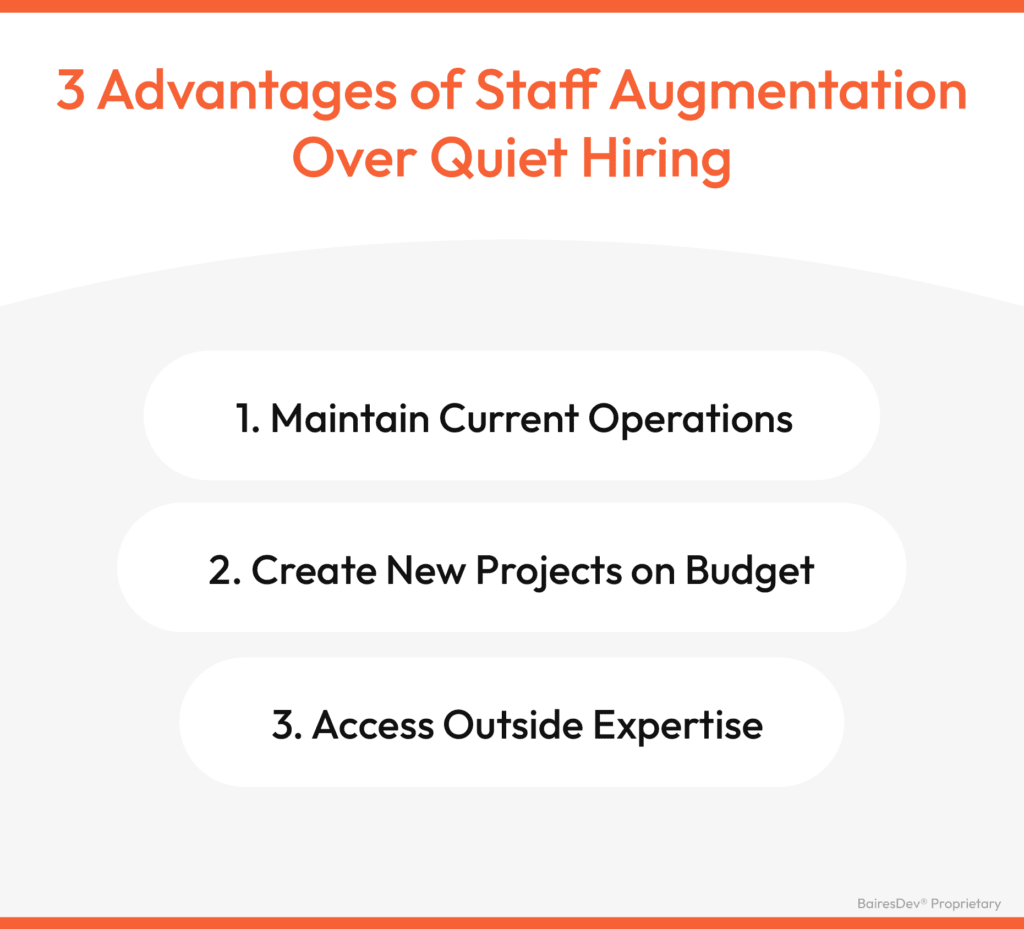Quiet hiring is an emerging trend of leveraging existing staff to fill roles without incurring additional hiring costs. According to a recent Skill Success survey, 70% of respondents have been involved in a job opportunity that wasn’t publicly advertised. While some of these opportunities are found on internal job boards, others fall squarely under the quiet hiring umbrella.
This strategy is skill-based rather than title-based recruitment, allowing companies to switch roles around to fill in gaps. But is this a smart resource reallocation or a risky short-term solution? In this article, I’ll weigh the pros and cons of quiet hiring vs. staff augmentation.
Weighing the Pros and Cons of Quiet Hiring
The notable positive of quiet hiring is its cost-effectiveness for companies. After all, they can condense two roles into one. The math speaks for itself. The salary of an entry-level software engineer can exceed $100,000 a year, making new tech hires a significant expense. With a good management model, reallocating tech resources is a must, and quiet hiring does just that. For example, if you have an excellent employee whose project is about to end, you can transition them to another active project. Businesses can sidestep new hires’ up-front expenses, like onboarding, recruiting, and benefits packages, by tapping into their existing workforce, ensuring critical project progress.
A study by Zavvy found that 34% of employees who left previous positions did so because of a lack of growth opportunities. Yet, job searching is tiring. On average, a candidate receives one interview request for every six applications. The Bureau of Labor Statistics found that the average duration of unemployment in the US as of April 2024 was 19.9 weeks. Quiet hiring enables employees to learn new skills and take on different responsibilities without confronting the job market. They can branch out to different departments and industries (in the case of outsourcing or agencies) and build up their resume without job hopping.
Quiet hiring promotes internal mobility. This approach helps companies tap into nontraditional talent pools by focusing on adjacent skills rather than rigidly adhering to previous job titles. It can potentially reduce hiring biases and promote diversity because employees are often chosen for new roles based on their accomplishments. However, this remains debatable since internal headhunting may lead to favoritism and the selection of nonminority profiles, even unconsciously.

While quiet hiring has some perks, it also has significant drawbacks. A critical one is the risk of employee burnout and dissatisfaction. After all, the company often condenses two roles into one. We all expect a pay raise after an increased workload, but that’s not always the case with quiet hiring. It’s not always portrayed as a promotion; the usual perks are often left out. A robust quiet hiring policy needs an element of negotiation to satisfy both sides, and that negotiation is more complex than quiet hiring can seem at first glance.
The pressure to perform in unfamiliar roles can also lead to skill gaps, quality issues, and missed deadlines. For instance, if a project ends at our company, we benefit from rolling talent into another project, but not without support. Recently, we had an engineer work on backend APIs for a healthcare company. As that project concluded, they moved on to data pipelines for an AI-powered marketing firm. In the switch, they connected weekly with a mentor experienced in similar data pipeline work. When quiet hiring simply plucks an individual from one area and drops them in another, there’s a high risk of error.
Apart from offering relevant training, which costs money, management must carefully weigh expectations and identify transferable skills. They must take these steps to avoid jeopardizing company KPIs with poor quiet hiring strategies. Quiet hiring can offer short-term solutions, but the practice requires a thoughtful process to ensure it remains a win-win for employers and employees.
Balancing Flexibility and Scalability With Staff Augmentation
Staff augmentation is a strategic solution that offers the flexibility to scale teams up or down as needed or add specific skills on demand. It doesn’t require long-term commitments or incur additional hiring costs.

Staff augmentation’s value lies in its ability to bring specialized skills to the table quickly. For instance, we collaborated with a digital media company that required a new portal for their affiliate program without disrupting the high-traffic pages. Ten backend engineers brought in through staff augmentation joined the project. This enabled the company to halve its time to market, reducing it from one year to six months. For tech-driven companies where revenue depends on uptime and quick-loading websites, that translates into big savings that surpass those achieved by strategic quiet hiring.
Similarly, in 2021, we worked with a veteran healthcare provider. They leveraged 37 engineers across 4 independent teams to develop 4 accessibility tools in just 11 months. Considering the time required for recruiting, onboarding, and training, achieving this scale internally within the same time frame would have been impossible.
Staff augmentation provides access to a broader talent pool. Companies can incorporate specialized skills like AI and machine learning where the demand for these experts far exceeds supply. Often, AI/ML skills are not present within a company, requiring resource-intensive training to reskill existing personnel. A company cannot cultivate this talent internally without an expert or mentor to provide necessary training. There is certainly merit in allowing a Python engineer to learn Ruby, but the importance of support and training must be factored into quiet hiring strategies.
Staff augmentation also presents challenges, such as seamlessly integrating external staff into the client’s company culture, teams, and technology. For instance, external developers must familiarize themselves with the client’s platforms. To facilitate this, our team mentors new joiners on company policy, software, and tools, ensuring a smooth transition. A good vendor has a structure that includes a project manager and an account manager who work hard on resource integration behind the scenes. Effective communication with the vendor is key to avoiding outsourcing misalignments. With careful vendor selection, staff augmentation can provide a strategic advantage without the risks associated with quiet hiring.

Staff Augmentation Is a Viable Alternative to Quiet Hiring
While quiet hiring is touted as a “win-win” by Gartner, its drawbacks reveal it to be more of a bandaid than a cure. The practice often leads to three red flags for a company’s bottom line:
- Damaging output/ KPIs by stretching employees too thin for good results.
- Stifling creativity and innovation by overburdening employees.
- Causing high turnover rates.
Let’s illustrate the points above with an example. Imagine that a tech company decides to reallocate a data engineer to launch a new marketing intelligence product while retaining 50% of their original duties. They begin a data warehouse migration for the new product but are soon interrupted by a security emergency in their original project. As deadlines for sprint deliverables for the marketing product approach, balancing both projects becomes increasingly challenging. This situation forces the engineer to pause one project or work overtime.
The increased workload will lead to burnout, and the engineer will likely quit six months later. The marketing product will remain incomplete, and the original project will need a new engineer. Replacing a data engineer (or two) costs the company more in turnover and training than augmenting their staff would have initially cost.
Quiet hiring may also foster uncertainty and stress as employees observe colleagues shifting roles unpredictably. While some thrive in dynamic environments, not all do. This uncertainty about role stability may lead employees to question their future with the company. They may feel compelled to seek stability elsewhere.
Staff augmentation is an overall viable alternative. It can help companies manage workload spikes without risking turnover. Here are three main advantages:
- Maintain Current Operations: With staff augmentation, nothing is left on the back burner, unlike quiet hiring, where employees are moved to different projects to fill gaps. Software updates can’t wait; otherwise, companies risk cybersecurity breaches.
- Create New Products on Budget: Businesses can deliver new products efficiently and increase revenue by maintaining current operations while adding specialized talent.
- Access Outside Expertise: External experts bring fresh perspectives and ideas. They often upskill internal teams in underrepresented languages, software, and DevOps best practices.

This final point is the cherry on top of software outsourcing. Innovation comes from fresh perspectives and collaboration across markets. Sometimes, after grappling with a problem for eight hours straight, the solution can strike as you tell a friend the issue over drinks. Because they are outsiders, they can look at the problem from a different angle and offer solutions when you’ve reached the end of the troubleshooting road.
Staff augmentation can be a catalyst for fresh ideas in tech. By transferring knowledge between industries and projects, innovation can scatter across fields. For instance, blockchain technology, initially designed for cryptocurrency transactions, now extends to healthcare (for secure patient data exchange), supply chain management (tracking product provenance), and digital identity verification.
Conclusion
We advocate sharing expertise across industries and projects. Partnering with a competent software outsourcer opens the door to more diverse solutions, multiplying your innovation potential.
While quiet hiring offers a cost-effective way to reallocate resources, its pitfalls—like employee burnout and compromised project quality—can’t be ignored. On the other hand, staff augmentation provides quicker and more thorough onboarding, specialized skills, and the ability to scale up and down. Additionally, it offers external expertise necessary for sustained growth and, most importantly, innovation. Staff augmentation emerges as the smarter, more strategic choice for companies aiming to balance immediate needs with long-term success.





